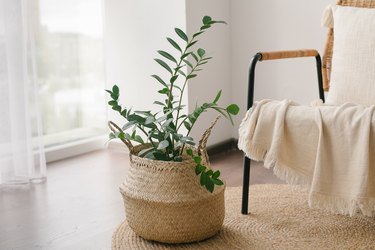
Green plants need light to grow in what is known as a "photosynthetic process," or as we commonly call it, photosynthesis. Without light, a plant will get taller, but not as a result of photosynthesis. Plants that grow in the dark simply stretch. Think of it as looking for the light. But without the light, they turn light green and often, white. Additional elements vital to plant growth are temperature, water, humidity and nutrition.
Not all plants have the same need for light. Full-sun and shade-adaptive plants react differently, and too much light can result in the plant reaching its compensation point, in which cells stop functioning effectively.
Video of the Day
Video of the Day
Measuring Plant Growth in Dark
Light is essential to photosynthesis. During the day when the sun is shining, a plant undergoes photosynthesis, storing energy for growth. When night falls, photosynthesis stops and respiration takes place, in which water and carbon dioxide are produced instead of being consumed, as in daylight hours. Succulents such as cacti take in carbon dioxide at night and store it for daylight hours.
Tropical, broad-leafed plants are well suited to low light or dark conditions. With large leaves soaking up as much light as possible, they store the energy for growth.
The Boston Fern (Nephrolepis exaltata), ZZ Plant (Zamioculcas zamiifolia) and the cast-iron plant (aspidistra) are three that do not require direct sunlight for growth.
And then there are mushrooms. Those grow-in-the-dark fungi aren't plants but parasites that take organic material from other plants or attach themselves to other plants and live off of their energy. They need moisture for growth, and light absorbs that moisture. An environment that is dark, warm and moist encourages growth.
Plants Grown in Dark Versus Light
Plant growth depends on the species of plant and environmental factors. While most plants grow faster at night, each species has its own growth rate. Large trees are the slowest growing plants on earth, while bamboo (Poaceae) can grow up to 2 inches in an hour. Warmer temperatures speed photosynthesis, and during daylight hours plants both photosynthesize and respire, although at night, photosynthesis drops off and respiration increases, resulting in growth spurts.
Plants left in the dark use stored energy and continue growing. But once that energy reserve is depleted, the plant may become long and thin, but it is also weak. Hydroponics answers this challenge by providing light to the plants only for a specific period of time before shutting it off and putting the plants in low light or darkness.
The Fight for Light
Plant growth in the dark is often a result of a race for whatever light is available. It's a competition for plants that are grown in close proximity to each other as they battle for light, space and the nutrition that the soil offers. Plants need darkness, just as humans do, to rest and recharge their metabolism. And darkness doesn't preclude growth. In fact, it enables it by taking the energy stored during the day through photosynthesis and using that energy for growth.
On the other end of the spectrum is the shameplant (Mimosa pudica), one of the most sensitive of plants. Touch it, and it folds into itself, a response to stimuli of the tiny hairs on its leaves. Changes in the environment, such as continuous light or nighttime drops in temperature affecting its blooming capability, cause it to wither and die. Finding the right light/dark ratio of the shameplant, and all plants, results in an optimum growing environment. It just takes experimentation with light, moisture, humidity and nutrition.